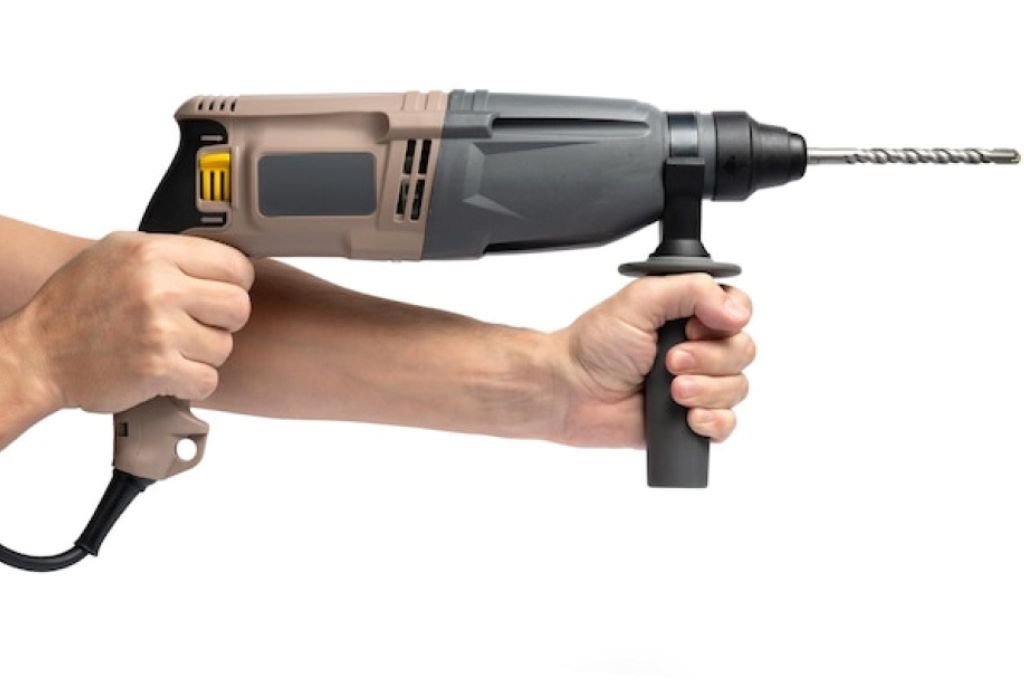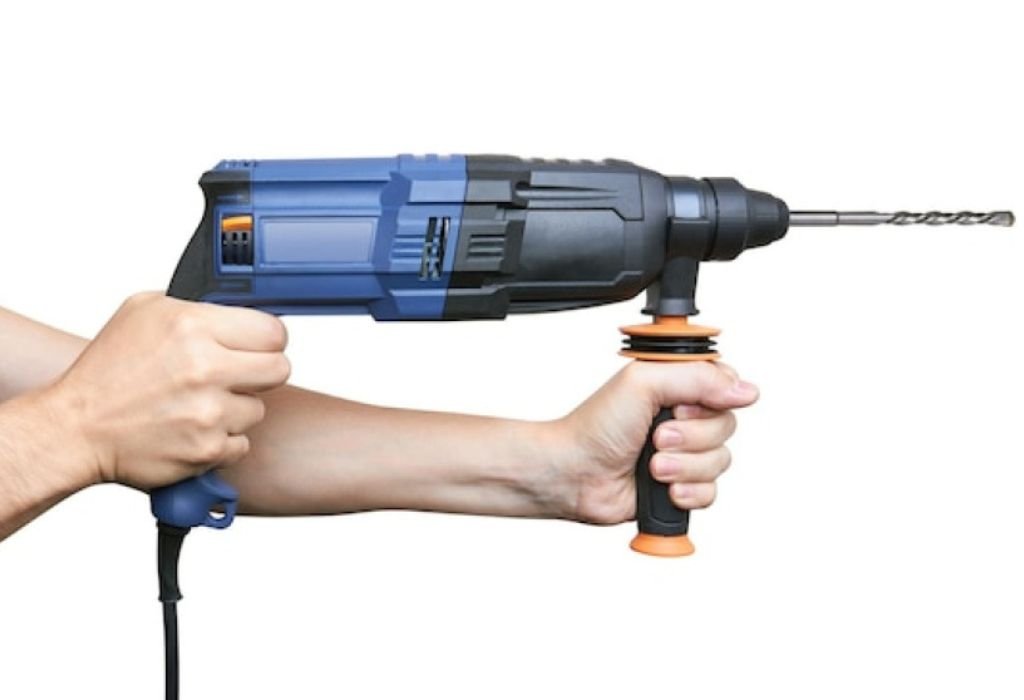A homeowner begins a bathroom remodel with a regular hammer and chisel. Hours pass, and the tiles barely come off. Switching to a rotary hammer drill turns the same job into a quick and effortless task.
This tool is often mistaken for a hammer drill, but its power and design make it much more versatile. With multiple modes and higher impact energy, it handles jobs that ordinary drills cannot.
The demand for heavy-duty tools continues to grow. The global power tools market is projected to surpass $43 billion by 2027 (Statista), and rotary hammer drills are a major driver of this expansion. Another study shows that over 65 percent of contractors use rotary hammer drills for masonry work because of their speed and efficiency.
So what is a rotary hammer drill used for, and why do professionals rely on it for concrete, stone, and demolition projects? Let’s break down its most important applications.
What Is a Rotary Hammer Drill Used For?

A rotary hammer drill is built for tasks that standard drills cannot handle. It is commonly used for drilling, chiseling, and breaking masonry, concrete, and stone.
This tool provides higher impact energy than a hammer drill. It is the go-to choice for contractors and DIYers tackling demanding projects.
Primary Applications of a Rotary Hammer Drill
Drilling into Concrete and Masonry
It easily drills anchor holes in reinforced concrete and brick. Normal drills struggle with these materials, but rotary hammers make the job quick and precise.
Tile and Floor Removal
In chisel mode, it removes tile, mortar, and flooring with ease. Renovations become faster and less labor-intensive.
Demolition and Breaking Work
It can break apart small slabs, asphalt, and brick walls. For medium demolition jobs, it is more practical than a full jackhammer.
Channeling for Wiring and Plumbing
Electricians and plumbers use it to cut neat channels in walls. This makes cable and pipe installation far easier.
Large-Scale Construction Projects
On job sites, it is used for foundation work, bridge projects, and tunnels. SDS-Max rotary hammers provide the heavy-duty performance needed for these jobs.
Why Choose a Rotary Hammer Drill for These Jobs
Rotary hammer drills save time by completing tough tasks in minutes. Their design reduces strain on the user while delivering professional results.
They are versatile thanks to multiple modes like drilling, hammer-drilling, and chiseling. This allows one tool to replace several others on the job.
Their impact power ensures clean and accurate holes in masonry. Anchors and bolts fit securely, making structures more reliable.
Contractors and serious DIYers prefer them for durability. These drills withstand constant heavy use far better than standard models.
Types of Rotary Hammer Drills and Their Uses
Rotary hammer drills come in different types. Each type is designed for specific projects and user needs.
Corded Rotary Hammer Drills
Corded models provide continuous power without interruptions. They are best for long drilling sessions and heavy-duty work.
Contractors often use them on job sites where constant drilling is required. Their only drawback is limited mobility due to the cord.
Cordless Rotary Hammer Drills
Cordless models run on rechargeable batteries. They are convenient for outdoor or remote work.
Modern batteries give them enough power for medium tasks. The downside is shorter runtime compared to corded models.
SDS-Plus Rotary Hammers
SDS-Plus drills are lightweight and versatile. They handle holes up to about 1 inch in masonry.
They are popular among homeowners, electricians, and plumbers. These models balance portability and efficiency.
SDS-Max Rotary Hammers
SDS-Max drills are heavy-duty machines. They accept larger bits and deliver higher impact energy.
They are ideal for industrial projects like foundations, bridges, and tunnels. Contractors rely on them for demanding construction jobs.
Choosing the Right Type
Home users benefit from cordless SDS-Plus drills. They are easy to handle and affordable.
Professionals should invest in corded SDS-Max drills. These provide maximum durability and power for large projects.
Safety Tips While Using a Rotary Hammer Drill
Rotary hammer drills are powerful tools. Using them safely prevents accidents and ensures better results.
Wear Protective Gear
Always wear safety goggles to shield your eyes from debris. Use ear protection and a dust mask when drilling into concrete.
Control Dust Hazards
Concrete dust contains silica, which is harmful if inhaled. Attach a dust extractor or connect the drill to a vacuum system.
Maintain Proper Grip and Stance
Hold the drill firmly with both hands. Keep a stable stance to control vibration and recoil.
Inspect Work Surfaces
Check walls and floors for hidden pipes or wires. Hitting these can cause damage or serious injury.
Follow Manufacturer Instructions
Use the recommended drill bits and settings. Apply lubrication when required to keep the tool safe and efficient.
Maintenance for Long-Term Performance
Rotary hammer drills handle tough jobs, so regular care is important. Proper maintenance keeps them reliable and extends their lifespan.
Clean After Each Use
Concrete dust builds up quickly and can clog vents. Wipe the tool and use compressed air to remove fine particles.
Lubricate SDS Chucks and Bits
Grease reduces friction and prevents wear. Always apply the manufacturer’s recommended lubricant before long drilling sessions.
Inspect and Replace Worn Bits
Damaged or dull bits put strain on the motor. Replace them as soon as you notice chips, cracks, or reduced efficiency.
Check Power Supply or Batteries
Corded models should be checked for frayed wires. Cordless models need batteries charged and stored in moderate temperatures.
Store Properly
Keep the drill in a dry, dust-free location. Use a protective case to prevent accidental damage.
Cost and Buying Considerations

Rotary hammer drills are available in a wide price range. The right choice depends on budget, usage frequency, and project type.
Average Price Ranges
Entry-level models cost between $100 and $150. They are suitable for light DIY work and occasional drilling.
Mid-range models range from $200 to $400. These are more powerful and durable, making them ideal for frequent use.
Professional-grade models start at $500 and can exceed $1,000. They are built for heavy-duty construction and continuous industrial use.
Popular Brands
Bosch, Makita, DeWalt, and Hilti are trusted brands. Each offers models for both homeowners and professionals.
Bosch and Makita provide strong mid-range options. Hilti focuses on premium, heavy-duty models used by contractors.
Features to Look For
Variable speed control improves accuracy when drilling different materials. Anti-vibration systems reduce fatigue during long jobs.
Dust extraction compatibility helps keep the workspace clean and safe. Multiple operating modes add versatility for drilling and chiseling.
Best Options for Different Users
Homeowners should consider cordless SDS-Plus models. They are portable, affordable, and easy to handle.
Contractors should invest in corded SDS-Max drills. These offer maximum durability and consistent performance for demanding projects.
FAQs About Rotary Hammer Drill Uses
1. What is a rotary hammer drill mainly used for?
It is used for drilling into concrete, stone, and masonry. It also handles chiseling and small demolition tasks.
2. Can it replace a regular drill?
Not completely. A regular drill is better for wood, metal, and light household projects.
3. Is it different from a hammer drill?
Yes, a hammer drill uses a clutch for light hammering. A rotary hammer drill uses a piston system for stronger impact.
4. Can I use it for wood or metal?
Yes, but only in drill-only mode. Standard drills are more efficient for these materials.
5. Is it good for tile removal?
Yes, chisel mode is perfect for removing tiles, mortar, and flooring. It saves hours of manual labor.
6. Can it be used for demolition?
Yes, it handles small to medium demolition jobs. For larger projects, a jackhammer is better.
7. Do I need special bits?
Yes, rotary hammer drills require SDS-Plus or SDS-Max bits. Standard drill bits will not fit properly.
8. How deep can it drill into concrete?
SDS-Plus drills make holes up to 1 inch. SDS-Max drills create much deeper and wider holes.
9. Is it safe for indoor use?
Yes, but always use dust control. Concrete dust can be harmful if inhaled.
10. Are cordless models powerful enough?
Yes, modern cordless models are strong for medium-duty tasks. Corded models are still better for heavy continuous use.
11. How heavy are rotary hammer drills?
They usually weigh between 5 and 15 pounds. SDS-Max models are the heaviest.
12. How long do they last?
With proper care, they last 5 to 10 years. Professional models often last longer under heavy use.
13. Is it worth buying for homeowners?
Yes, if you do frequent masonry or renovation work. If not, renting may be a better choice.
14. Can I use it to drill anchor holes?
Yes, it is ideal for drilling secure anchor holes in reinforced concrete. This is one of its most common uses.
15. Do professionals prefer rotary hammer drills?
Yes, most contractors rely on them for concrete and masonry. Their power and speed make them essential on job sites.
Conclusion
A rotary hammer drill is more than a tool for drilling holes. It is a versatile machine that handles concrete, masonry, tile removal, and even small demolition work with ease.
Its piston-driven power and multiple modes make it faster and more efficient than standard drills. From homeowners tackling renovations to contractors working on large sites, it saves time and delivers professional results.
Choosing the right type depends on your needs. Cordless SDS-Plus drills are great for light to medium work, while corded SDS-Max drills provide maximum power for industrial projects.
If your next project involves concrete, stone, or brick, consider using a rotary hammer drill. It will transform difficult jobs into smooth and efficient tasks.

I’m John F. Nicholas, the founder, lead writer, and drill enthusiast behind 101drill.com. With years of hands-on experience in power tools and DIY projects, I created this platform to share practical knowledge, expert tips, and real-world insights to help others master the art of drilling.
